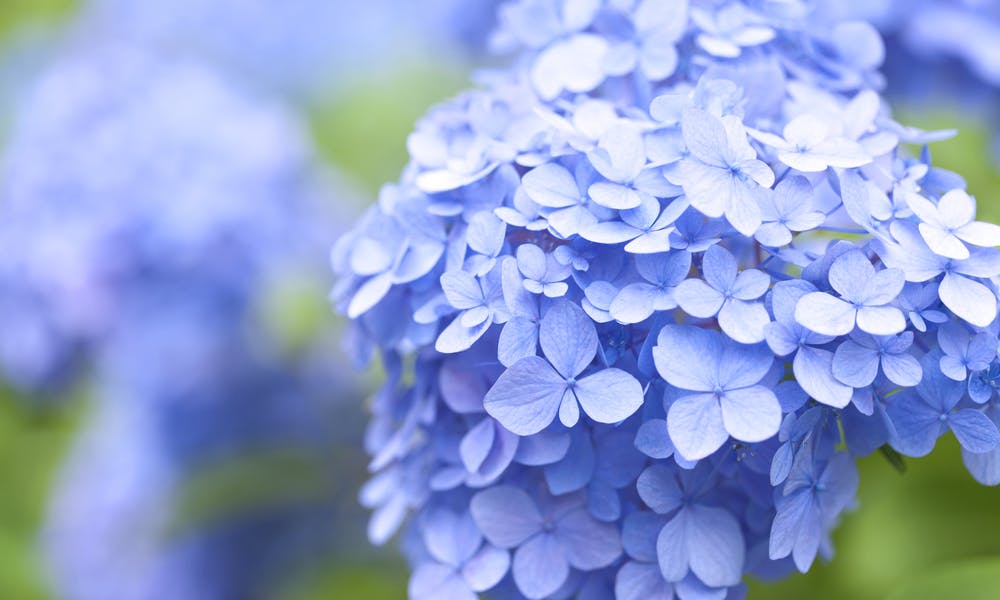MENU
The Hydrangea Flower

The lovely hydrangea flower has been capturing the hearts and minds of humans around the world ever since it was first discovered. These beautiful clusters of flowers adorn many a garden, lighting up homes everywhere they have been planted. The flower even has its own holiday in American culture, with January 5th being hydrangea day. Whether it’s their place in popular culture, growth tips or just some fun history, we explore all there is to know about the hydrangea.
Keep on reading to find out:
- The Origins of the Hydrangea
- Flower Details
- Modern Symbolism
- Hydrangea Myths
- Use in Japanese Culture
- Cuisine and Medicine
- How to Grow Your Own
The Origins of the Hydrangea
The hydrangea is a flowering plant with close to 80 species within its genus. Native to parts of Asia such as Japan, Korea, and China, as well as in the Americas, the hydrangea has become a common sight in most parts of the world for its beautiful large flowerheads. The oldest fossil remains were found in Alaska, dating back over 20 million years ago. The name hydrangea stems from the Greek word for water vessel, which refers to the shape of its seeds. The h.macrophylla variety has been the most widely cultivated, with over 600 cultivars currently existing. The hydrangea was named the official state flower of Alabama back in 1999.
Flower Details
Growing upon small trees, shrubs, and lianas, the hydrangea can grow anywhere from 1 to 30 meters tall, with both deciduous and evergreen species existing. Typically growing in panicles or corymbs, they can most often be found at the end of stems. There are usually two types of flowers on the flowerheads; tiny ones within the center and large, showy sepals on the exterior. They generally extend outwards in a ring pattern. The most common varieties of hydrangea are white, although many other colors such as purple, pink, blue, and red can be found. This swath of color can be produced with a simple manipulation of the soil acidity wherever they are planted, although keep in mind that the white variety does not change color regardless of the acidity. One of the few plants that gather aluminium ions, this trait is what leads to its lovely blue color.
Modern Symbolism
Hydrangeas have a host of symbolism associated with their beauty and vivid colors throughout modern society. The traditional flower for the fourth wedding anniversary, they are thought to represent sincerity and genuine love and emotion. Amusingly, the hydrangea has come to be associated with boastfulness as the plant produces many flowers but very few seeds.
Hydrangea Myths
There is a myth in Japan that tells of an ancient emperor, who having angered a woman he loved deeply due to his neglect of her in favor of his work, gifted her with a bunch of hydrangea flowers as a symbol of his gratitude for her, and as a symbol of his deep emotion towards her. In some Asian cultures, to gift a hydrangea to another is to say that you consider them to be as important to you as the beat of your heart.
Use in Japanese Culture
In Japanese culture, ama-cha, which translates to sweet tea, is an herbal tea made from the hydrangea plant. The fresh leaves are broken down, steamed, and then dried, which yields dark brown leaves. On the 8th of April every year, the ama-cha is used in the bathing ceremony of Buddha, called kan-butsu-e. It is thought to be Buddha’s birthday. The tea is poured over a statue of Buddha. It is said in legend that when Buddha was born, nine dragons covered him in amrita. In modern times the ama-cha is used as a substitute for amrita.
Cuisine and Medicine
It is very much not recommended to ingest any part of the hydrangea flower, as it is quite toxic and not fit for human nor animal consumption. On the other hand, from a medicinal standpoint, it has some uses. The root and the rhizome of the hydrangea have some medical properties. They have been used to help treat urinary tract problems, with some evidence of benefit towards infections of the bladder, prostate, and urethra. They may aid with kidney stones, as well as with prostate enlargement. Some cultures use it in the treatment of hay fever also.
How to Grow Your Own
Hydrangeas are not too difficult to grow, needing well-drained soil with lots of organic matter. Rooting them in sandy areas, with lots of shade is best as they do not do well in very hot or dry environments. Plant them about a foot deep, and water them well. As their name implies, hydrangea flowers require a lot of water to flourish, with one or more heavy watering’s per week recommended. Fertilizing them with a general-purpose fertilizer throughout the spring season is ideal. Take care when pruning, as the flowers appear only on last year’s growth, so only prune the stems from the present year’s growth otherwise it may not bloom the following year. If not pruned often, hydrangeas can break apart under their own weight, so be watchful. Most hydrangea varieties blossom in summer and fall.
The Lovely Hydrangea
From the blue island of Faial in Portugal to the lovely Buddhist tea ceremony of Japan, the hydrangea flower abounds with symbolism and beauty in cultures around the world. For those looking to spruce up their gardens or simply to brighten up their dreary workstations, the hydrangea is a gorgeous flower to bring into your life. Having your own plant around can be the perfect way to have a steady stream of gifts to bestow on a lover who you have been neglecting, or simply for your future wedding anniversary. Don’t miss out!

